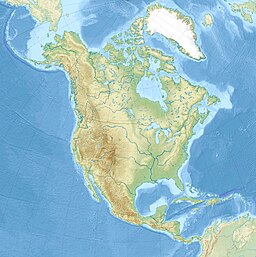| Lake Erie | |
|---|---|
| Waabishkiigoo-gichigami / Aanikegamaa-gichigami (Ojibwe) | |
 NOAA satellite image of Lake Erie from July 7, 2023. Light green swirls are algae bloom on the western edge of the lake. | |
 Lake Erie and Lake Saint Clair bathymetric map.[1][2][3][4] The deepest point is marked with "×".[5] | |
| Location | North America |
| Group | Great Lakes |
| Coordinates | 42°12′N 81°12′W / 42.2°N 81.2°W |
| Lake type | Glacial |
| Primary inflows | Detroit River[6] |
| Primary outflows | Niagara River Welland Canal[7] |
| Basin countries | |
| Max. length | 241 mi (388 km) |
| Max. width | 57 mi (92 km) |
| Surface area | 9,910 sq mi (25,700 km2)[7] |
| Average depth | 62 ft (19 m)[7] |
| Max. depth | 210 ft (64 m)[8] |
| Water volume | 116 cu mi (480 km3)[7] |
| Residence time | 2.6 years |
| Shore length1 | 799 mi (1,286 km) plus 72 mi (116 km) for islands[9] |
| Surface elevation | 569 ft (173 m)[7] |
| Islands | 24+ (see list) |
| Settlements | Cleveland, Ohio Buffalo, New York Erie, Pennsylvania Toledo, Ohio Monroe, Michigan Leamington, Ontario Port Colborne, Ontario |
| References | [8] |
| 1 Shore length is not a well-defined measure. | |

Lake Erie (/ˈɪri/ EER-ee; French: Lac Érié) is the fourth-largest lake by surface area of the five Great Lakes in North America and the eleventh-largest globally.[6][10] It is the southernmost, shallowest, and smallest by volume of the Great Lakes[11][12] and also has the shortest average water residence time. At its deepest point, Lake Erie is 210 feet (64 m) deep, making it the only Great Lake whose deepest point is above sea level.[13]
Situated on the International Boundary between Canada and the United States, Lake Erie's northern shore is the Canadian province of Ontario, specifically the Ontario Peninsula, with the U.S. states of Michigan, Ohio, Pennsylvania, and New York on its western, southern, and eastern shores. These jurisdictions divide the surface area of the lake with water boundaries. The largest city on the lake is Cleveland, anchoring the third largest U.S. metro area in the Great Lakes region, after Greater Chicago and Metro Detroit. Other major cities along the lake shore include Buffalo, New York; Erie, Pennsylvania; and Toledo, Ohio.
Situated below Lake Huron, Erie's primary inlet is the Detroit River. The main natural outflow from the lake is via the Niagara River, which provides hydroelectric power to Canada and the U.S. as it spins huge turbines near Niagara Falls at Lewiston, New York, and Queenston, Ontario.[14] Some outflow occurs via the Welland Canal, part of the Saint Lawrence Seaway, which diverts water for ship passages from Port Colborne, Ontario, on Lake Erie, to St. Catharines on Lake Ontario, an elevation difference of 326 ft (99 m). Lake Erie's environmental health has been an ongoing concern for decades, with issues such as overfishing, pollution, algae blooms, and eutrophication generating headlines.[15][16]
- ^ Cite error: The named reference
GLBathErwas invoked but never defined (see the help page). - ^ Cite error: The named reference
GLBathHurwas invoked but never defined (see the help page). - ^ Cite error: The named reference
GLBathOntwas invoked but never defined (see the help page). - ^ Cite error: The named reference
GLOBEwas invoked but never defined (see the help page). - ^ Cite error: The named reference
NOAA_GLERLwas invoked but never defined (see the help page). - ^ a b Cite error: The named reference
StateofOhiowas invoked but never defined (see the help page). - ^ a b c d e Cite error: The named reference
EPAwas invoked but never defined (see the help page). - ^ a b Cite error: The named reference
nytwas invoked but never defined (see the help page). - ^ Shorelines of the Great Lakes Archived April 5, 2015, at the Wayback Machine
- ^ Cite error: The named reference
worldatlas listwas invoked but never defined (see the help page). - ^ Cite error: The named reference
GLIN F&Fwas invoked but never defined (see the help page). - ^ "Erie, Lake - FactMonster". www.factmonster.com. Archived from the original on February 29, 2012. Retrieved September 5, 2006.
- ^ "Great Lakes Profile". Vivid Maps. January 18, 2017. Archived from the original on November 23, 2023. Retrieved January 10, 2024.
- ^ Cite error: The named reference
twsZ54was invoked but never defined (see the help page). - ^ Cite error: The named reference
twsZ61was invoked but never defined (see the help page). - ^ Cite error: The named reference
NYT031413was invoked but never defined (see the help page).
